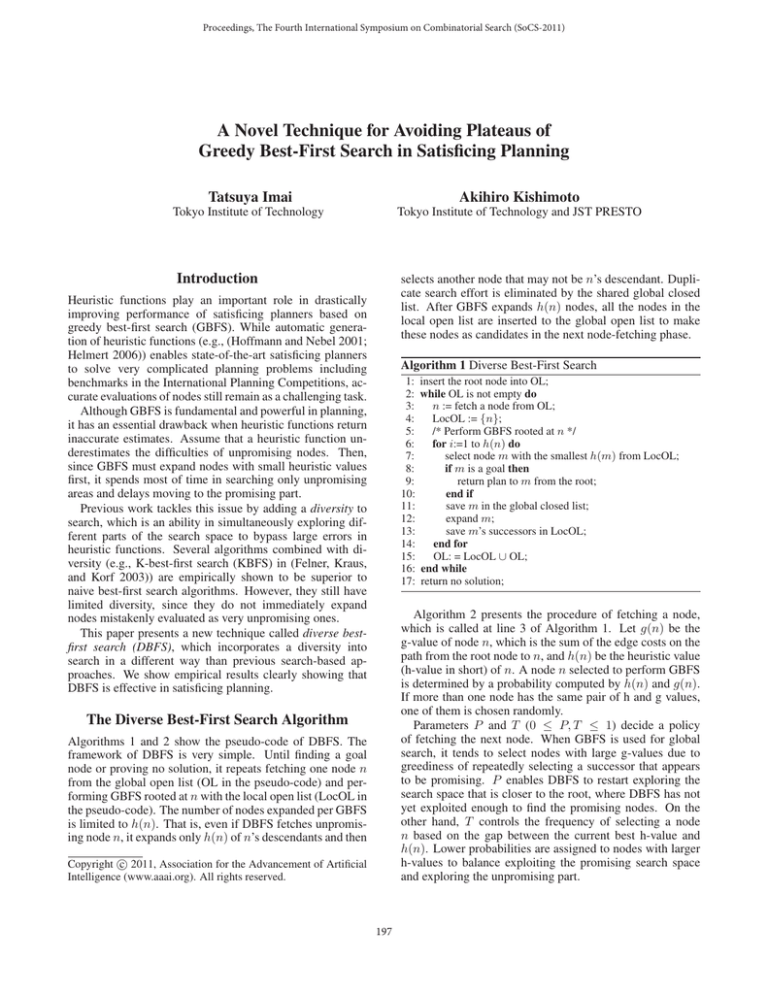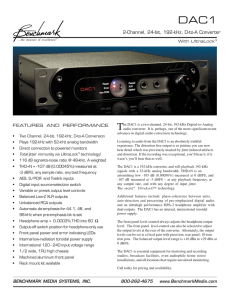
Proceedings, The Fourth International Symposium on Combinatorial Search (SoCS-2011)
A Novel Technique for Avoiding Plateaus of
Greedy Best-First Search in Satisficing Planning
Tatsuya Imai
Akihiro Kishimoto
Tokyo Institute of Technology
Tokyo Institute of Technology and JST PRESTO
selects another node that may not be n’s descendant. Duplicate search effort is eliminated by the shared global closed
list. After GBFS expands h(n) nodes, all the nodes in the
local open list are inserted to the global open list to make
these nodes as candidates in the next node-fetching phase.
Introduction
Heuristic functions play an important role in drastically
improving performance of satisficing planners based on
greedy best-first search (GBFS). While automatic generation of heuristic functions (e.g., (Hoffmann and Nebel 2001;
Helmert 2006)) enables state-of-the-art satisficing planners
to solve very complicated planning problems including
benchmarks in the International Planning Competitions, accurate evaluations of nodes still remain as a challenging task.
Although GBFS is fundamental and powerful in planning,
it has an essential drawback when heuristic functions return
inaccurate estimates. Assume that a heuristic function underestimates the difficulties of unpromising nodes. Then,
since GBFS must expand nodes with small heuristic values
first, it spends most of time in searching only unpromising
areas and delays moving to the promising part.
Previous work tackles this issue by adding a diversity to
search, which is an ability in simultaneously exploring different parts of the search space to bypass large errors in
heuristic functions. Several algorithms combined with diversity (e.g., K-best-first search (KBFS) in (Felner, Kraus,
and Korf 2003)) are empirically shown to be superior to
naive best-first search algorithms. However, they still have
limited diversity, since they do not immediately expand
nodes mistakenly evaluated as very unpromising ones.
This paper presents a new technique called diverse bestfirst search (DBFS), which incorporates a diversity into
search in a different way than previous search-based approaches. We show empirical results clearly showing that
DBFS is effective in satisficing planning.
Algorithm 1 Diverse Best-First Search
1:
2:
3:
4:
5:
6:
7:
8:
9:
10:
11:
12:
13:
14:
15:
16:
17:
insert the root node into OL;
while OL is not empty do
n := fetch a node from OL;
LocOL := {n};
/* Perform GBFS rooted at n */
for i:=1 to h(n) do
select node m with the smallest h(m) from LocOL;
if m is a goal then
return plan to m from the root;
end if
save m in the global closed list;
expand m;
save m’s successors in LocOL;
end for
OL: = LocOL ∪ OL;
end while
return no solution;
Algorithm 2 presents the procedure of fetching a node,
which is called at line 3 of Algorithm 1. Let g(n) be the
g-value of node n, which is the sum of the edge costs on the
path from the root node to n, and h(n) be the heuristic value
(h-value in short) of n. A node n selected to perform GBFS
is determined by a probability computed by h(n) and g(n).
If more than one node has the same pair of h and g values,
one of them is chosen randomly.
Parameters P and T (0 ≤ P, T ≤ 1) decide a policy
of fetching the next node. When GBFS is used for global
search, it tends to select nodes with large g-values due to
greediness of repeatedly selecting a successor that appears
to be promising. P enables DBFS to restart exploring the
search space that is closer to the root, where DBFS has not
yet exploited enough to find the promising nodes. On the
other hand, T controls the frequency of selecting a node
n based on the gap between the current best h-value and
h(n). Lower probabilities are assigned to nodes with larger
h-values to balance exploiting the promising search space
and exploring the unpromising part.
The Diverse Best-First Search Algorithm
Algorithms 1 and 2 show the pseudo-code of DBFS. The
framework of DBFS is very simple. Until finding a goal
node or proving no solution, it repeats fetching one node n
from the global open list (OL in the pseudo-code) and performing GBFS rooted at n with the local open list (LocOL in
the pseudo-code). The number of nodes expanded per GBFS
is limited to h(n). That is, even if DBFS fetches unpromising node n, it expands only h(n) of n’s descendants and then
c 2011, Association for the Advancement of Artificial
Copyright Intelligence (www.aaai.org). All rights reserved.
197
Algorithm 2 Fetching one node
12:
13:
14:
15:
16:
17:
18:
19:
20:
21:
ptotal := 0;
(hmin , hmax ) := minimum and maximum h-values in OL;
(gmin , gmax ) := minimum and maximum g-values in OL;
if with probability of P then
G := select at random from gmin , · · · , gmax ;
else
G := gmax ;
end if
for all h ∈ {hmin , · · · , hmax } do
for all g ∈ {gmin , · · · , gmax } do
if g > G or OL has no node whose h-value and g-value
are h and g, respectively then
p[h][g] := 0;
else
p[h][g] := T h−hmin ;
end if
ptotal := ptotal + p[h][g];
end for
end for
select a pair of h and g with probability of p[h][g]/ptotal ;
dequeue a node n with h(n) = h and g(n) = g in OL;
return n;
DBFS
1:
2:
3:
4:
5:
6:
7:
8:
9:
10:
11:
additional instances in several domains compared to GBFS.
However, KBFS usually achieved smaller performance improvements than DBFS.
Figure 1 compares the number of nodes expanded by
GBFS and DBFS with the FF heuristic for the instances
solved by both. The node expansion of GBFS was plotted
on the horizontal axis against DBFS on the vertical axis on
logarithmic scales. A point below the linear line indicates
that DBFS expanded fewer nodes than GBFS in solving one
instance. Figure 1 clearly shows that DBFS outperformed
6
10
5
10
4
10
3
100 0
10
1
10
2
10
3
4
10
10
GBFS
5
10
10
6
10
7
Figure 1: Comparison of node expansions between GBFS
and DBFS with the FF heuristic
GBFS especially when solving hard instances.
DBFS often returned longer solutions than GBFS, since
DBFS selected unpromising nodes that tend to be on a more
redundant path to a goal. However, since DBFS still yielded
similar plans in many cases, this is a price to pay for achieving performance improvements.
We also evaluated the performance of DBFS with the FF
heuristic and preferred operators, against the state-of-the-art
Fast Downward (FD) planner with the best combination of
enhancements (alternation based on the FF and CEA heuristics, deferred evaluation, preferred operators and boosting
(Helmert 2006; Richter and Helmert 2009)). A smaller
number of enhancements was incorporated into DBFS than
FD. However, while FD solved only 1,458 instances, DBFS
solved 1,481 instances.
References
Felner, A.; Kraus, S.; and Korf, R. E. 2003. KBFS: Kbest-first search. In Annals of Mathematics and Artificial
Intelligence, volume 39, 19–39.
Helmert, M., and Geffner, H. 2008. Unifying the causal
graph and additive heuristics. In Proceedings of ICAPS
2008, 140–147.
Helmert, M. 2006. The Fast Downward planning system.
Journal of Artificial Intelligence Research 26:191–246.
Hoffmann, J., and Nebel, B. 2001. The FF planning system:
Fast plan generation through heuristic search. Journal of
Artificial Intelligence Research 14:253–302.
Richter, S., and Helmert, M. 2009. Preferred operators and
deferred evaluation in satisficing planning. In Proceedings
of ICAPS 2009, 273–280.
Table 1: The number of instances solved by each algorithm
KBFS
1,288
1,218
1,240
10
101
We evaluated the performance of DBFS, GBFS and KBFS.
All the experiments were run on a dual quad-core 2.33
GHz Xeon E5410 machine with 6 MB L2 cache. The
time and memory limits for solving an instance were set
to 30 minutes and 2 GB. We built all the implementations
on top of the Fast Downward planner (Helmert 2006). We
ran these three search algorithms with either the FF (Hoffmann and Nebel 2001), causal graph (CG) (Helmert 2006),
or context-enhanced additive (CEA) (Helmert and Geffner
2008) heuristic. The other enhancements in Fast Downward
were turned off. We used 1,612 planning instances in 32
domains from the past five International Planning Competitions for the experiments. We ran DBFS with same parameters P = 0.1 and T = 0.5 and same random seed for all the
instances. Although we included the best result in the paper
after measuring the performance with several random seeds
and various P and T , DBFS was very robust to the changes
of these parameters. On the other hand, We ran KBFS(2l )
for all the cases of integer l satisfying 0 ≤ l ≤ 7, and included the best result for each problem.
GBFS
1,209
1,170
1,202
7
102
Experiments
Heuristic
FF
CG
CEA
10
DBFS
1,451
1,358
1,388
Table 1 shows the number of instances solved by each algorithm. Table 1 clearly indicates the superiority of DBFS
to KBFS and GBFS. DBFS solved the largest number of instances with all heuristic functions. In particular, DBFS either solved an equal or larger number of instances than the
others in all the domains with the FF heuristic. KBFS solved
198







